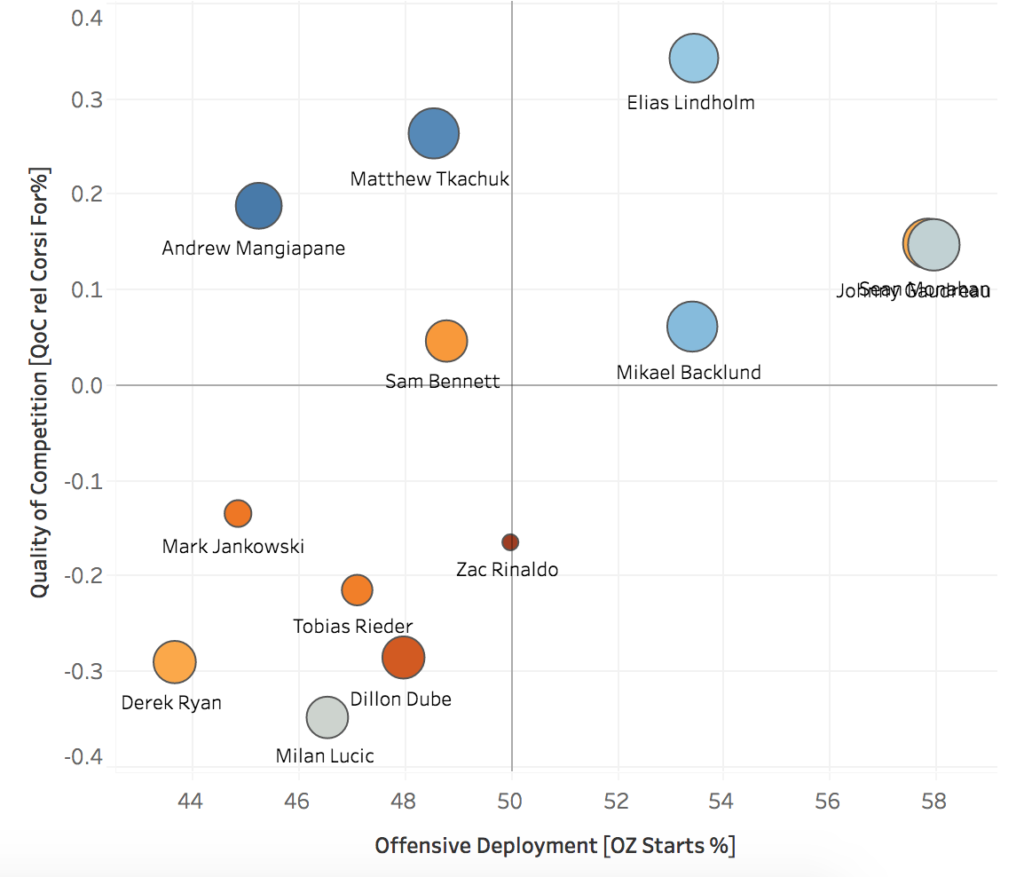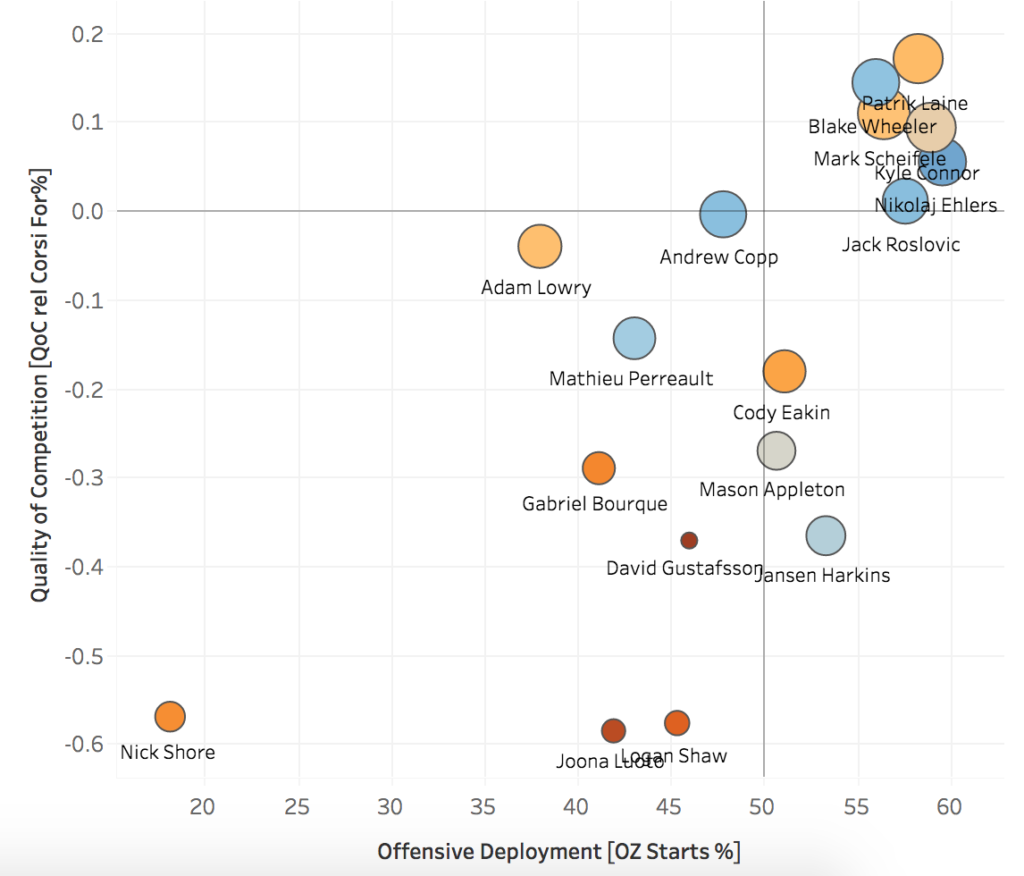Flames vs. Jets preview: forwards

By Ryan Pike
3 years agoThe Calgary Flames face the Winnipeg Jets beginning on Saturday in a qualifying round match-up. The Jets have the perceived edge in goal while the Flames have an advantage on the blueline. How do their forward groups match up?
The Flames
Players in Bubble:
Johnny Gaudreau (26 years old; 464 NHL games, 445 NHL points) – Sean Monahan (25; 541, 411) – Lindholm (25; 525, 320)
Andrew Mangiapane (24; 122, 45) – Mikael Backlund (31; 690, 365) – Matthew Tkachuk (22; 293, 235)
Milan Lucic (32; 958, 521) – Sam Bennett (24; 364, 128) – Dillon Dube (22; 70, 21)
Zac Rinaldo (30; 370, 42) – Derek Ryan (33; 302, 136) – Tobias Rieder (27; 434, 138)
Alan Quine (27; 106, 28) – Mark Jankowski (25; 208, 64) – Austin Czarnik (27; 121, 38)
Byron Froese (29; 110, 16) – Buddy Robinson (28; 12, 3)
Andrew Mangiapane (24; 122, 45) – Mikael Backlund (31; 690, 365) – Matthew Tkachuk (22; 293, 235)
Milan Lucic (32; 958, 521) – Sam Bennett (24; 364, 128) – Dillon Dube (22; 70, 21)
Zac Rinaldo (30; 370, 42) – Derek Ryan (33; 302, 136) – Tobias Rieder (27; 434, 138)
Alan Quine (27; 106, 28) – Mark Jankowski (25; 208, 64) – Austin Czarnik (27; 121, 38)
Byron Froese (29; 110, 16) – Buddy Robinson (28; 12, 3)
Here’s a snapshot of Flames forward usage in 2019-20:

The Flames top line is well-established, and the addition of Elias Lindholm last season means that while they do get oodles of offensive zone starts they end up facing fairly tough opposition – something that fed into Bill Peters’ “strength against strength” line-matching preference that is shared by Geoff Ward.
The second line, 3M 2.0, is about as good at shutting down opposing stars as the first 3M incarnation was. Andrew Mangiapane has been a revelation this season, particularly with his ability to step in for Michael Frolik (after his move to Buffalo) and not miss a beat.
The bottom six is a bit of a two-tiered group, with Milan Lucic and Dillon Dube working the wings of the third line, Tobias Rieder and Zac Rinaldo on the wings of the fourth line, and some combination of Derek Ryan, Mark Jankowski and Sam Bennett up the middle. (Right now Jankowski seems to be the odd man out.) As the player usage chart indicates, these trios are given the easier lifting to do.
Calgary’s depth forwards are entirely built out of guys who have played in the NHL before, but are now in the AHL. They’re older, but useful, depth players who can be short-notice plug-and-play options for the fourth line. That said, you’d be nervous about using them anywhere but the fourth line, and the team’s depth will be tested a bit if there’s a top six (or even top nine) injury and somebody from the fourth line group has to move their way up. Aside from Bennett and Ryan, you don’t want anybody from the fourth line playing too far above their station.
The Jets
Players in Bubble:
Kyle Connor (23; 249, 201) – Mark Scheifele (27; 519, 444) – Blake Wheeler (33; 931, 761)
Nikolaj Ehlers (24; 369, 257) – Cody Eakin (29; 586, 237) – Patrik Laine (22; 305, 247)
Andrew Copp (26; 356, 110) – Adam Lowry (27; 408, 123) – Jack Roslovic (23; 180, 67)
Mathieu Perreault (32; 627, 324) – Nick Shore (27; 299, 59) – Mason Appleton (24; 82, 18)
Gabriel Bourque (29; 413, 103) – Jansen Harkins (23; 29, 7) – Mark Letestu (35; 567, 210)
David Gustafsson (20; 22, 1) – Logan Shaw (28; 215, 36)
Nikolaj Ehlers (24; 369, 257) – Cody Eakin (29; 586, 237) – Patrik Laine (22; 305, 247)
Andrew Copp (26; 356, 110) – Adam Lowry (27; 408, 123) – Jack Roslovic (23; 180, 67)
Mathieu Perreault (32; 627, 324) – Nick Shore (27; 299, 59) – Mason Appleton (24; 82, 18)
Gabriel Bourque (29; 413, 103) – Jansen Harkins (23; 29, 7) – Mark Letestu (35; 567, 210)
David Gustafsson (20; 22, 1) – Logan Shaw (28; 215, 36)
Here’s Winnipeg’s forward usage in 2019-20:

Like Ward, Jets coach Paul Maurice opts for strength against strength and lots of offensive zone starts for his team’s top guns. As you can see, the possession numbers are kind of all over the place for the team (blue is good, red is bad) – injuries meant Maurice had to almost pick names out of a hat for lines this season, so things are a bit of a jumble.
As a result, the Jets’ slated lines have less of a clear demarcation of roles than Calgary’s do, and they tend to have one (or maybe two) good possession players out with a guy that’s less good at that part of hockey. The top six features five quite good offensive players, plus Cody Eakin, and while you won’t mistake either group for a shutdown line (ala 3M 2.0), they’re not slouches in the defensive end.
The Jets’ third line is one to watch out for, as all three players have speed and smarts and it could be a deceptively strong play-driving line given how strong Roslovic and Copp are at that part of the game. The fourth line is a bit of a jumble, with Perreault trying to keep the other two afloat.
Winnipeg’s depth features an up-and-comer in Gustafsson – no relation to the Flames’ defender – and some veteran depth guys who are destined for the fourth line. Gustafsson could be used all over the place in the event of injury, but the rest of them are a bit more limited in their potential uses.
The edge
Honestly, this looks like a pretty even series in terms of the two forward groups.
The Flames’ second line is probably the best shutdown trio among the two teams (and their first line is pretty potent), but Winnipeg’s top six is well-balanced and pretty opportunistic, and Maurice is a savvy coach who will try to use his deployments to find them some daylight.
Similarly, the Jets’ third line is arguably the best bottom six group among both teams, but the Flames’ move of Bennett to the third line could be an interesting X-factor – Ryan as a fourth line center could elevate that group in a way similar to Perreault as a winger on the Jets’ fourth line.
The depth groups are basically a toss-up, though if Gustafsson can find a spark the Jets may have a slight edge. The Flames’ older depth guys may have a bit more tread left on the tires than Bourque, Shaw and Letestu, though.
If the Flames can rely on structure and make this series a chess match, the two-way play of their core players could be a difference. If it’s a bit run and gun, that skews more towards the Jets’ forte. As it stands, we don’t know how things will unfold so it’s a bit of a toss-up with a slight potential edge to the Flames.
Recent articles from Ryan Pike





